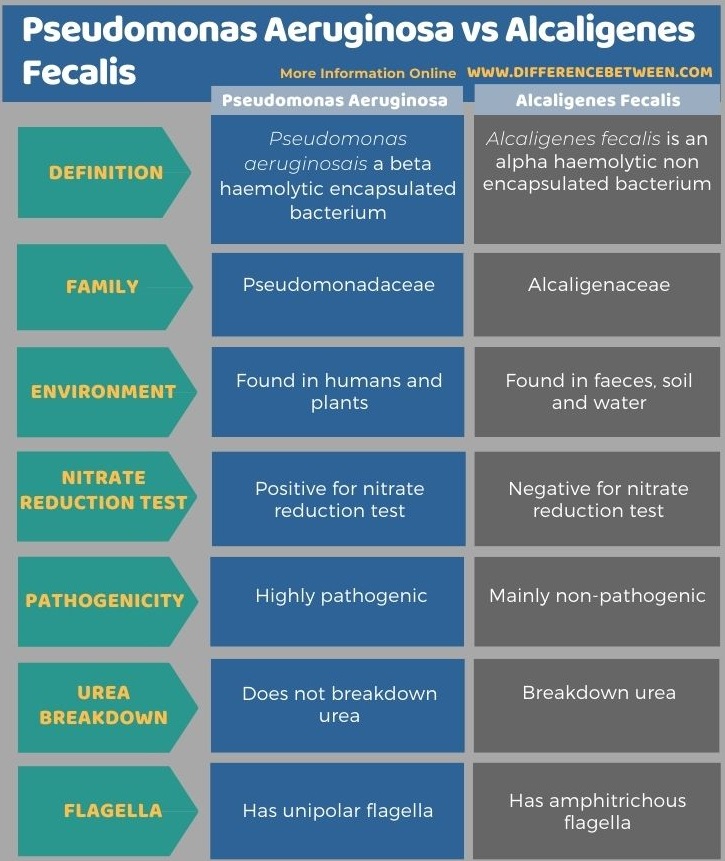The key difference between Pseudomonas aeruginosa and Alcaligenes fecalis is that Pseudomonas aeruginosa is a beta-haemolytic encapsulated bacterium while Alcaligenes fecalis is an alpha haemolytic non encapsulated bacterium.
Pseudomonas aeruginosa and Alcaligenes fecalis are gram negative, rod-shaped, aerobic bacteria. They belong to the phylum Proteobacteria. Pseudomonas aeruginosa belongs to the family of Pseudomonadaceae while Alcaligenes fecalis belongs to the family of Alcaligenaceae. P. aeruginosa has been identified as an opportunistic pathogen in both humans and plants. Though A. fecalis is generally an opportunistic pathogen, it has been identified as a non-pathogenic bacterium that is commonly found in the environment.
CONTENTS
1. Overview and Key Difference
2. What is Pseudomonas Aeruginosa
3. What is Alcaligenes Fecalis
4. Similarities Between Pseudomonas Aeruginosa and Alcaligenes Fecalis
5. Side by Side Comparison – Pseudomonas Aeruginosa vs Alcaligenes Fecalis in Tabular Form
6. Summary
What is Pseudomonas Aeruginosa?
Pseudomonas aeruginosa is a gram-negative, rod-shaped, aerobic bacterium with unipolar motility. In certain instances, it becomes a facultative anaerobic. The identification of P. aeruginosa is often very complicated as individual isolates lack motility. Moreover, mutations in the gene called lasR drastically alter their colony morphology and ordinarily, leading to failure to hydrolyse gelatin or haemolyze. It has been identified as an opportunistic bacterium in both humans and plants. Sometimes in certain conditions, P. aeruginosa can secrete a variety of pigments such as pyocyanin (blue), pyoverdine (yellow and fluorescent), pyorubin (red), and pyomelanin (brown). These features can be used to identify this bacterium. P. aeruginosa is clinically identified by its ability to produce both pyocyanin and fluorescein, as well as its ability to grow at 420 C. This bacterium is capable of growing in diesel and jet fuels. It is also known as a hydrocarbon-using microorganism, causing microbial corrosion.

Figure 01: Pseudomonas aeruginosa
The genome of P. aeruginosa consists of a relatively large chromosome (5.5 – 6.8 Mb) with 5500 – 6000 open reading frames and plasmids of various sizes. This organism is popular for quorum sensing and biofilms formation. Moreover, this bacterium is resistant to a large range of antibiotics, including carbapenems, polymyxins, and recently tygecyclin.
P. aeruginosa causes urinary tract infections, respiratory tract infections, dermatitis, soft tissue infections, bacteraemia, bone and joint infections, gastrointestinal tart infections, and a variety of systematic infections. The antibiotics that may have an effect against P. aeruginosa include aminoglycosides, quinolones, cephalosporins, antipseudomonal penicillins and monobactams.
What is Alcaligenes Fecalis?
Alcaligenes fecalis is a gram-negative, rod-shaped bacterium found commonly in the environment. It was originally found in faeces. However, it is present in the soil, water, and environments in association with humans. This bacterium causes opportunistic infections. However, it is generally considered non-pathogenic. When opportunistic, it usually causes urinary tract infections. A. fecalis has been used for the production of non-standard amino acids over the years.
This microorganism is oxidase and catalase positive. But it is negative for the nitrate reductase test. A. fecalis grows at 37 0C and forms colonies that lack pigmentation. Moreover, A. fecalis degrades urea, creating ammonia which increases the pH of the environment. Though A. fecalis is considered to be alkali-tolerant, it maintains neutral pH in the cytosol to prevent damaging its macromolecules. A. faecalis is normally resistant to aminoglycosides, chloramphenicol and tetracyclines. In any case, it is usually susceptible to trimethoprim, sulfamethoxazole and β-lactam antibiotics, including ureidopenicillins, ticarcillin–clavulanic acid, cephalosporins and carbapenems.
What are the Similarities Between Pseudomonas Aeruginosa and Alcaligenes Fecalis?
- Both bacteria belong to the phylum proteobacteria.
- They are gram-negative and rod-shaped bacteria.
- Both are aerobic.
- Moreover, they are opportunistic pathogens.
- They both are oxidase and catalase-positive.
- Both are motile bacteria.
What is the Difference Between Pseudomonas Aeruginosa and Alcaligenes Fecalis?
P. aeruginosa is a beta-haemolytic encapsulated bacterium. In contrast, A. fecalis is an alpha haemolytic non encapsulated bacterium. So, this is the key difference between Pseudomonas Aeruginosa and Alcaligenes Fecalis. In beta haemolysis, complete lysis of red blood cells and haemoglobin takes place, while in alpha haemolysis, partial breakdown of red blood cells happens, leaving a greenish colour.
Moreover, P. aeruginosa is positive for the nitrate reduction test while A. Fecalis is negative for the nitrate reduction test. Thus, this is another important difference between Pseudomonas Aeruginosa and Alcaligenes Fecalis. Furthermore, P. aeruginosa is highly pathogenic while A. fecalis is mainly non-pathogenic. Also, P. aruginosa is unable to break down urea while A. fecalis is able to break down urea.
The below infographic lists the differences between Pseudomonas Aeruginosa and Alcaligenes Fecalis in tabular form for side by side comparison.

Summary – Pseudomonas Aeruginosa vs Alcaligenes Fecalis
P. aeruginosa and A. fecalis both are gram negative, rod-shaped, and aerobic bacteria. P. aeruginosa is a beta haemolytic encapsulated bacterium while A. fecalis is an alpha haemolytic non encapsulated bacterium. Though they are both opportunistic, P. aeruginosa is highly pathogenic, while A. fecalis is mainly non-pathogenic. Biochemical tests such as urea hydrolysis test and nitrate reduction test can be used to differentiate P. aeruginosa and A. fecalis. Thus, this summarizes the difference between Pseudomonas Aeruginosa and Alcaligenes Fecalis.
Reference:
1. “Pseudomonas Aeruginosa.” Wikipedia, Wikimedia Foundation, 1 Apr. 2021, Available here.
2. “Alcaligenes Faecalis.” Wikipedia, Wikimedia Foundation, 24 Feb. 2021, Available here.
Image Courtesy:
1. “Pseudomonas aeruginosa” By Microbe World (CC BY-NC-SA 2.0) via Flickr
ncG1vNJzZmivp6x7pbXFn5yrnZ6YsqOx07CcnqZemLyue8OinZ%2Bdopq7pLGMm5ytr5Wau2680p6snaedpLuiv4yanKutl567sL%2FAZpinnF2WuaSty6KenqaVqHqnscKao6KrXw%3D%3D